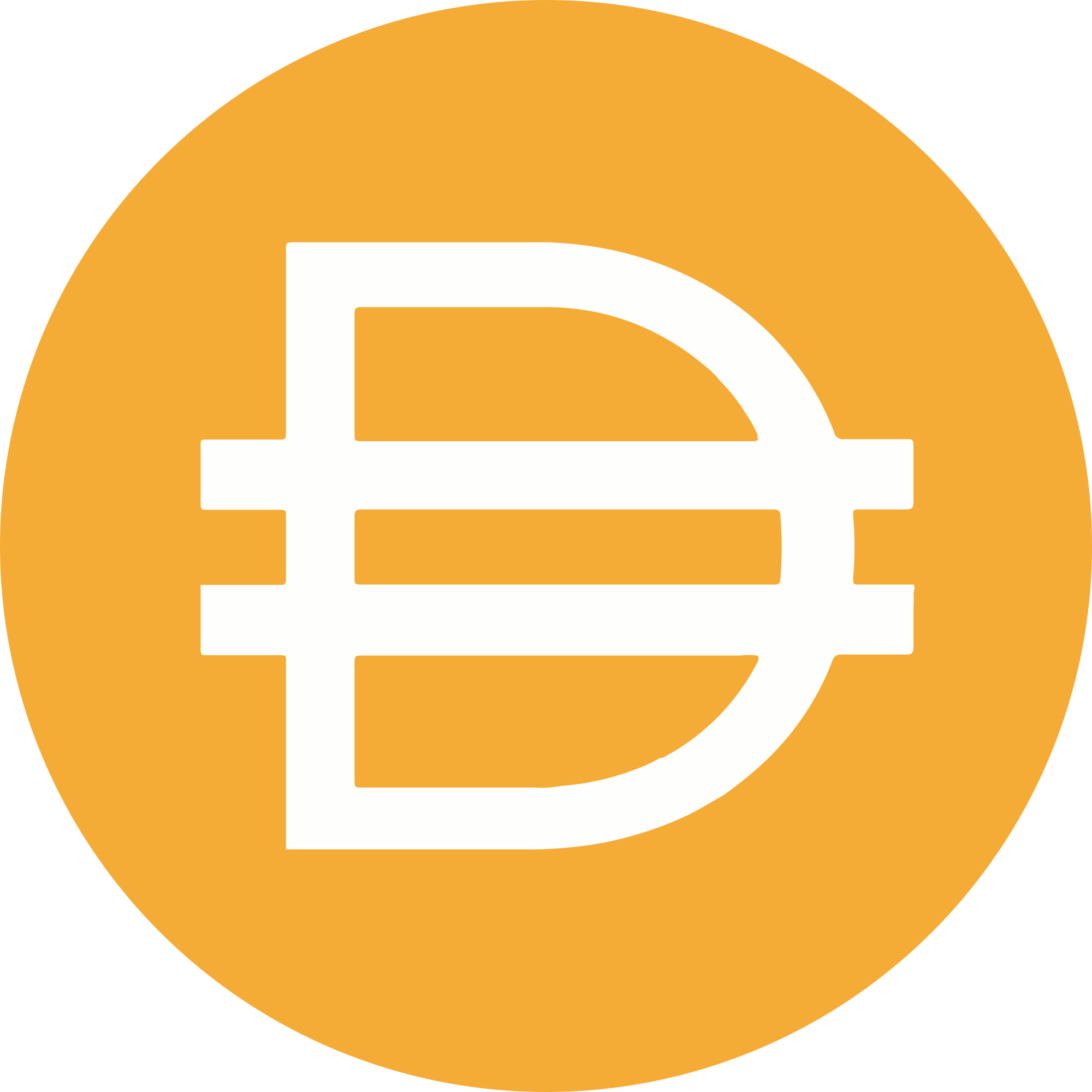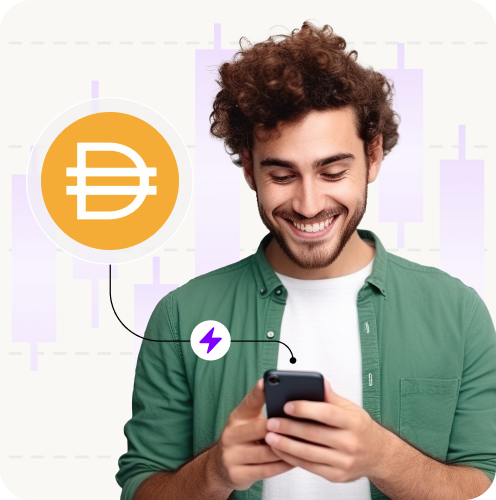
DAI Price
DAI
DAI Price in USD
Datos en Vivo del Precio DAI
El precio en vivo de DAI (DAI) es actualmente {{current_price}}, {{price_change_percentage_24h_in_currency}} en las últimas 24 horas. DAI está actualmente en el puesto {{market_cap_rank}} por capitalización de mercado, que se calcula multiplicando el precio actual ({{current_price}}) por el suministro circulante ({{circulating_supply}}), y tiene un suministro total de {{total_supply}}. Compre DAI a la tasa actual de MoonPay:

Acerca de DAI
Dai (DAI) es una stablecoin criptomoneda que opera en el Ethereum blockchain. Fue creado por MakerDAO, una organización autónoma descentralizada (DAO), con el objetivo de proporcionar una moneda digital estable y descentralizada que no esté sujeta a la misma volatilidad del mercado que a menudo se asocia con otras criptomonedas como Bitcoin o Ethereum.
Dai está vinculado al valor del dólar estadounidense. Esto significa que el valor de 1 Dai siempre está destinado a ser equivalente a 1 dólar estadounidense. Esta estabilidad se logra a través de un sistema de contratos inteligentes y colateralización.
Para crear Dai, los usuarios deben bloquear una cierta cantidad de Éter (ETH), que sirve como colateral. Este colateral se mantiene en un contrato inteligente llamado un Posición de Deuda Colateralizada (CDP). Los usuarios pueden generar Dai contra este colateral utilizando el CDP como garantía.
Una de las principales ventajas de Dai es su descentralización. A diferencia de las stablecoins tradicionales que están respaldadas por una autoridad central o se mantienen en una cuenta bancaria, Dai opera completamente en la cadena de bloques de Ethereum, utilizando contratos inteligentes para su funcionalidad. Esto significa que ninguna entidad tiene control directo sobre el suministro o el valor de Dai, lo que lo hace resistente a la censura y la manipulación.
Dai se ha vuelto cada vez más popular en aplicaciones descentralizadas (dApps), proporcionando un medio de intercambio estable y confiable dentro del finanzas descentralizadas (DeFi) ecosistema.
DAI es una moneda estable vinculada al dólar estadounidense. Por lo tanto, su valor siempre ronda los $1 por DAI (+/- $0.001). Sin embargo, ha habido ocasiones en las que el precio de Dai fluctuó de este umbral, antes de volver a la marca de $1.
2017-2019
El precio de DAI se mantuvo relativamente estable hasta 2019, cotizando entre $0.9999 y $1.01 durante la mayor parte del año.
2020
El precio de DAI fue notablemente volátil, particularmente en la primera mitad de 2020, alcanzando alturas de $1.14 por token en septiembre. Esta volatilidad del precio probablemente se pueda atribuir al inicio de la pandemia de COVID-19.
2021
El mercado de criptomonedas experimentó una tremenda tendencia alcista en 2021, pero DAI se mantuvo estable durante todo el tiempo, excepto en el mes de septiembre cuando brevemente alcanzó un máximo histórico de $3.67.
2022
El token DAI fue estable en 2022, oscilando entre un precio de $0.9995 y $1.001.
2023
DAI se mantuvo estable durante todo el 2023, excepto por una gran caída en marzo cuando alcanzó su precio más bajo de $0.9729.
A diferencia de las monedas estables tradicionales que están respaldadas por reservas de moneda fiduciaria, Dai logra su estabilidad a través de un mecanismo descentralizado que involucra contratos inteligentes y colateralización. El principal colateral utilizado para respaldar Dai es Ether (ETH), la criptomoneda nativa de la blockchain de Ethereum. Los usuarios que desean generar Dai pueden depositar su Ether en un contrato inteligente llamado Posición de Deuda Colateralizada (CDP). El Ether depositado sirve como colateral y, según su valor, los usuarios pueden crear y pedir prestada una cantidad equivalente de Dai.
La cantidad de Dai que se puede generar está determinada por el índice de colateralización, que es establecido por el protocolo Maker. Inicialmente, la relación de colateralización se fijó en 150%, lo que significa que por cada 1 Dai generado, debía haber $1.50 de ETH bloqueado.
Si el valor del colateral cae y la relación de colateralización supera un umbral predeterminado (actualmente fijado en 150%), el CDP de un usuario puede ser liquidado. Esto significa que el colateral se vende para pagar el Dai generado, lo que ayuda a mantener la estabilidad y solvencia del sistema Dai.
Para mantener la estabilidad, el sistema MakerDAO emplea el Módulo Estabilizador del Sistema. Si el valor de Dai comienza a desviarse del precio objetivo, se crea un incentivo para aumentar o disminuir la oferta de Dai en circulación. Por ejemplo, si el precio de Dai sube por encima de $1, los usuarios pueden crear y vender nuevos tokens Dai, lo que ayuda a bajar el precio. Por el contrario, si el precio cae por debajo de $1, los usuarios pueden comprar y quemar Dai, reduciendo la oferta y elevando el precio.
Dai (DAI) fue creado por MakerDAO, una organización autónoma descentralizada que desarrolló la stablecoin y el protocolo de software subyacente, el Maker Protocol. Aunque no hay un individuo o grupo específico considerado como los fundadores de Dai, el proyecto MakerDAO fue iniciado por Rune Christensen.
Rune Christensen es una figura prominente en el espacio de las criptomonedas y ha desempeñado un papel fundamental en el desarrollo y la gobernanza de MakerDAO. Ha sido instrumental en impulsar la visión e implementación de la stablecoin Dai y el Maker Protocol.
Dai sirve para múltiples propósitos dentro del ecosistema de criptomonedas. Proporciona un almacenamiento de valor relativamente estable, ofreciendo una alternativa a las criptomonedas volátiles como Bitcoin o Ethereum. Las personas pueden mantener o ahorrar sus activos en Dai con menos riesgo de fluctuaciones significativas del mercado debido a su paridad con el dólar estadounidense.
La moneda estable también funciona como medio de intercambio, permitiendo a los usuarios realizar transacciones cotidianas. La naturaleza rápida y segura de Dai permite transferencias rápidas y confiables, lo que hace posible que las personas realicen compras o envíen fondos sin depender de los sistemas bancarios tradicionales. Su utilidad como medio de intercambio proporciona conveniencia y accesibilidad a los usuarios que buscan transaccionar con una moneda digital estable y descentralizada.
Además, Dai facilita remesas transfronterizas de bajo costo y eficientes. Al aprovechar la tecnología blockchain, las personas pueden enviar Dai a destinatarios en cualquier parte del mundo, eludiendo intermediarios y reduciendo las tarifas de transacción. Esta característica hace de Dai una opción atractiva para las personas que buscan agilizar y simplificar el proceso de envío de dinero a través de fronteras, promoviendo la inclusión financiera y la accesibilidad a escala global.
Dai es único en que es una moneda estable descentralizada que ofrece estabilidad, transparencia y descentralización en el volátil mundo de las criptomonedas.
A diferencia de otras monedas estables que están respaldadas por una autoridad central o mantenidas en una cuenta bancaria, Dai opera completamente en la cadena de bloques de Ethereum a través de contratos inteligentes, eliminando la necesidad de confiar en una entidad centralizada. Su valor se mantiene a través de un sistema de colateralización y mecanismos de contratos inteligentes, proporcionando estabilidad y vinculándolo al dólar estadounidense.
Esta descentralización y estabilidad hacen de Dai una moneda digital versátil que puede ser utilizada para diversos propósitos, incluidas las transacciones comerciales internacionales, las remesas y la participación en DeFi.
Dai (DAI) no se puede minar ni apostar de la manera tradicional como otras criptomonedas como Bitcoin o Ethereum. Dai es una moneda estable que opera en la cadena de bloques de Ethereum, y su emisión no se basa en un proceso de minería o staking.
La creación de Dai implica un mecanismo diferente llamado "colateralización". Los usuarios pueden crear Dai bloqueando activos colaterales, típicamente en forma de Ether (ETH), en un contrato inteligente llamado Posición de Deuda Colateralizada (CDP). La cantidad de Dai que se puede generar está determinada por el índice de colateralización establecido por el sistema MakerDAO.
Para generar Dai, necesitarías interactuar con el protocolo Maker y seguir los procesos y requisitos específicos establecidos por MakerDAO. Esto generalmente implica acceder a plataformas o interfaces que te permitan crear y administrar CDPs, como el sitio web oficial de MakerDAO o plataformas de finanzas descentralizadas (DeFi) compatibles.
Es importante tener en cuenta que el proceso de generación de Dai implica riesgos, incluido el potencial de liquidación de tu colateral si cae por debajo del índice de colateralización requerido. Se recomienda comprender a fondo los mecanismos, riesgos y requisitos asociados con la generación de Dai antes de participar en el proceso.

DAI Price Performance
| Change | Amount | % |
|---|
DAI Price Information
24h Low & High
0.00High:
0.00
Monedas similares a DAI
Más preguntas frecuentes sobre DAI
Existen mecanismos establecidos para ayudar a mantener la estabilidad de Dai y mantener su precio lo más cercano posible a su paridad prevista de 1:1 con el dólar estadounidense.
Cuando la demanda de Dai aumenta y su precio supera el objetivo de paridad, la tarifa de estabilidad puede aumentarse para alentar a los usuarios a generar más Dai, aumentando así la oferta y acercando el precio de nuevo hacia la paridad. Por el contrario, si el precio de Dai cae por debajo de la paridad, la tarifa de estabilidad puede reducirse para incentivar a los usuarios a pagar su Dai pendiente y reducir la oferta.
El máximo histórico de DAI es de $3.67, que ocurrió el 16 de noviembre de 2021.
El mínimo histórico de DAI es de $0.897, que se alcanzó el 11 de marzo de 2023.
El número de tokens DAI en circulación puede variar con el tiempo a medida que se acuñan o queman nuevos DAI. Actualmente, hay casi {{circulating_supply}} tokens DAI en circulación. El suministro total de Dai no tiene un límite máximo, lo que significa que no hay un límite máximo fijo en el número de tokens Dai que pueden existir. El suministro de Dai es dinámico y se ajusta según la demanda de los usuarios y la colateralización del sistema. A medida que los usuarios generan Dai contra su colateral, el suministro aumenta, y si el Dai se devuelve o se liquida, el suministro disminuye.
Puedes comprar DAI directamente a través de MoonPay o mediante uno de nuestros muchos monederos asociados, como Trust Wallet y Exodus. El sencillo widget de MoonPay facilita la compra de Dai con tarjeta de crédito o débito, transferencia bancaria, Apple Pay, Google Pay y más métodos de pago. También puedes agregar fondos a tu monedero en euros, libras o dólares y usar tu saldo de MoonPay para comprar criptomonedas como DAI. Haz tus transacciones más fluidas y asequibles, todo con tasas de aprobación más altas.

.png?w=3840&q=90)
.png?w=3840&q=90)

